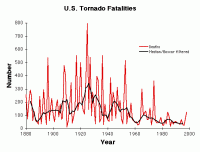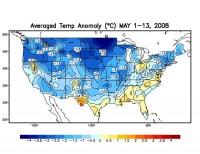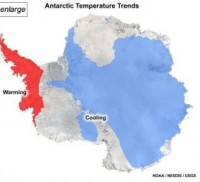
|
May 17, 2008
32,000 Deniers
By Lawrence Solomon, Financial Post
The Oregon Institute of Science and Medicine’s Petition Project of 2001 by all rights should have settled the issue of whether the science was settled on climate change. To establish that the effort was bona fide, and not spawned by kooks on the fringes of science, as global warming advocates often label the skeptics, the effort was spearheaded by Dr. Frederick Seitz, past president of the National Academy of Sciences and of Rockefeller University, and as reputable as they come.
The Oregon petition garnered an astounding 17,800 signatures, a number all the more astounding because of the unequivocal stance that these scientists took: Not only did they dispute that there was convincing evidence of harm from carbon dioxide emissions, they asserted that Kyoto itself would harm the global environment because “increases in atmospheric carbon dioxide produce many beneficial effects upon the natural plant and animal environments of the Earth.”
The petition drew media attention, but little of it was for revealing to the world that an extraordinary number of scientists hold views on global warming diametrically opposite to those they are expected to hold. Instead, the press focussed on presumed flaws that critics found in the petition. Some claimed the petition was riddled with duplicate names. They were no duplicates, just different scientists with the same name. Some claimed the petition had phonies. There was only one phony: Spice Girl Geri Halliwell, planted by a Greenpeace organization to discredit the petition and soon removed. Other names that seemed to be phony - such as Michael Fox, the actor, and Perry Mason, the fictional lawyer in a TV series were actually bona fide scientists, properly credentialled.
Original signatories to the petition and others, outraged at Kyoto’s corruption of science, wrote to the Oregon Institute and its director, Arthur Robinson, asking that the petition be brought back. “E-mails started coming in every day,” he explained. “And they kept coming.” The writers were outraged at the way Al Gore and company were abusing the science to their own ends. “We decided to do the survey again.”
Using a subset of the mailing list of American Men and Women of Science, a who’s who of Science, Robinson mailed out his solicitations through the postal service, requesting signed petitions of those who agreed that Kyoto was a danger to humanity. The response rate was extraordinary, “much, much higher than anyone expected, much higher than you’d ordinarily expect,” he explained. He’s processed more than 31,000 at this point, more than 9,000 of them with PhDs, and has another 1,000 or so to go - most of them are already posted on a Web site at petitionproject.org.
Why go to this immense effort all over again, when the press might well ignore the tens of thousands of scientists who are standing up against global warming alarmism? “I hope the general public will become aware that there is no consensus on global warming,” he says, “and I hope that scientists who have been reluctant to speak up will now do so, knowing that they aren’t alone.”
See more here. If you wish to sign the petition and think you qualify go here and print sign and mail it in with brief reasons why you think so. Also a national coalition of pastors, Christian leaders, and policy makers announced the Thursday, May 15, of the “We Get It!” campaign aimed at enlisting one million Christians on a new, historic statement on environment and poverty. See more here.
May 17, 2008
2nd Opinion: Facing Fears and Global Warming
By Dr. John Christy in the Texas Baptist Standard
With all of the pending disasters blamed on global warming blasting their way through the media, I can understand why many might fear the future climate. We are told emissions of greenhouse gases, mainly carbon dioxide (CO2), are destroying not only polar bears and petunias, but the planet as a whole. If we don’t “stop global warming,” The End will surely come. I am a climate scientist. My research and that of many others does not lead me to be afraid for the climate’s future. However, I am fearful for other reasons:
I fear for my science. The truth is, our climate system is so complex that we cannot predict its state even into next month. Nonetheless, I see high-profile individuals (usually untrained in science) making claims with unwavering confidence about the climate’s trajectory and a looming catastrophe. I do not see the humility this science demands. In fact, I suspect an anthropologist, isolated from the media, would observe this global-warming fervor as a religion complete with anointed authority figures, sacred documents, creeds, sins requiring absolution, castigation of heretics and even an apocalypse. But science doesn’t work by arguments-from-authority or depth-of-feeling. Lord Kelvin said, “All science is numbers.” Our scientific discoveries should be the same, whether one is a Baptist, Buddhist or Bahai. However, if Ive learned one thing in this business, it is that we scientists are mere mortals, and we succumb to pride as easily as anyone else. Claiming to know exactly how the climate works and what it will do decades from now has as much to do with belief as science.
I fear for humanity. When people speak about “doing something about global warming,” please listen carefully. What they advocate are “solutions,” which lead to rationing of energy while having no climate impact. A hidden consequence of these “solutions” is to make energy more expensive-a regressive burden disproportionately inflicted upon the poorest among us. Is this what we should promote? Is this the message of Christ? One fact I learned as a missionary in Africa is this: Without energy, life is brutal and short. Denying energy expansion in the developing world, which many advocate, is to condemn them to suffering and poverty.
The simple truth is that whatever the climate does-and our research at the University of Alabama in Huntsville does not support predictions of an impending disaster-the regulations proposed to date and promoted by the green agenda will have no measurable effect. Read more here.
John Christy earned a master’s degree from Golden Gate Seminary and master’s and doctoral degrees from the University of Illinois. He is the distinguished professor of atmospheric science and director of the Earth Systems Science Center at the University of Alabama in Huntsville, studying global climate since 1987. He and his wife, Babs, served as Southern Baptist journeyman missionaries in Kenya 35 years ago. His website is here.
May 14, 2008
The Archibald Prize
By David Archibald
In last Thursday’s West Australian, John Connelly of The Climate Institute said that I am destroying the environment. I have written a reply. Do read on.
John Connor of The Climate Institute says that my boat, my car and I are destroying the environment. My work says the opposite. The more carbon dioxide you put into the atmosphere, the more you are helping all plants on the planet to grow, and of course that makes you a better person. Virtue is in direct proportion to your carbon dioxide output. What of the temperature, you ask? Carbon dioxide is a greenhouse gas, but the effect is strongly logarithmic. The first 20 ppm achieves 1.5 degrees of heating, but it takes more than another 400 ppm to equal that. By the time we get to the current level of 384 ppm, carbon dioxide is tuckered out as a greenhouse gas. From here, every 100 ppm extra may be worth 0.1 of a degree.
So how does the IPCC achieve 5 degrees of heating from a doubling of the pre-industrial level of carbon dioxide to 560 ppm? They do it by cheating. Their computer models are written so that a little bit of carbon dioxide-caused heating puts more water vapour in the air. Water vapour is the major greenhouse gas, so they have the heating compounding away until they get a number that will melt icecaps, kill polar bears and all the other effects of their apocalyptic visions. Their view of the Earth’s climate is that it is tremendously unstable, prone to thermal runaway at the slightest provocation. In fact it is the opposite, a buffered system that dampens disturbances. Tropical seas can’t get warmer than 31 degrees because they start evaporating too rapidly to get any hotter. Similarly, high level tropical clouds part to vent radiation to space. The Earth is just about perfect for sustaining equable living conditions over a good proportion of its surface
What is strange is that the wailing of the global warming proponents is in the face of a temperature record that does not support their theory. Peak global temperature was in 1998 and we have had ten years of cooling since. The satellite record shows that the temperature of the Southern Hemisphere has been flat for the last 30 years. The Earth’s failure to warm has become quite annoying to the global warmers, and signs of cognitive dissonance are appearing in their camp. Surely a few more years of cooling will leave only the true believers in their misanthropic ideology, and the truly idiotic. Or is that moment with us now?
Can cooling continue, or is climate just a random walk? Not only will it continue, substantial cooling next decade is in the bag based on current solar behaviour. There is a good correlation between solar cycle length and the temperature over the following solar cycle. Long solar cycles cause lower temperatures. The classic case is the Dalton Minimum between 1796 and 1820. This was a time of crop failures in Europe and the US, and of the Thames freezing over in winter, caused by the weak amplitude of Solar Cycles 5 and 6. Solar cycles are normally 11 years long. Solar Cycle 4 which preceded the Dalton Minimum was a long one at 13.6 years. We are currently near the end of Solar Cycle 23, which is already 12 years long and showing no signs of finishing this year. It is already two and a half years longer than the one that preceded it. With 0.7 degrees of cooling for every extra year of solar cycle length, we already have 1.7 degrees of cooling in the bag for the mid-latitudes. Read more of this excellent reply here. Read former paper with forecasts for the United States here.
May 12, 2008
Very Active Tornado Season Another Classic La Nina Effect
By Joseph D’Aleo, CCM
The winter and spring brought heavy, in places all-time record snowfall, flooding, and now an active tornado season. All of these are classic strong La Nina phenomena. Brush fires now ablaze in Florida are is also a common springtime La Nina hazard. Almost daily tornadoes have been in the news with 910 reported to date (as of 5 am Tuesday). 97 deaths have also been reported. We have not had a superoutbreak (yet) as we did in 1974 (The Great Superoutbreak) or 1965 (Palm Sunday Outbreak), but a lot a very active days. Given the pattern with a strong suppressed jet stream and lots of high latitude blocking more active days can be expected.
The most fatalities from tornadoes occurred in the 1920s (peak 1928) (source NSSL). In recent decades, deaths were less with the exception of the two years with SUPER OUTBREAKS, 1965 and 1974 (both years coming off La Nina winters, in 1974, one of the strongest)

See larger graph here.
See this entire story with more on those superoutbreaks here.
Don’t let anyone tell you this is the result of global warming. This May has with the exceptions of a few pockets, been a cold month so far thanks to high latitude blocking and a suppressed jet stream. With that forecast to continue, expect more widespread unseasonably cool temperatures and severe weather ahead.
 See larger image here.
See larger image here.
May 11, 2008
That Darned Water Vapor
By Craig James, WOOD-TV Blog
If you’ve read many of my past posts, you may remember that the main reason I (and many other meteorologists) disagree with the computer model forecasts of how much warming will occur due to an increase in CO2 is because of how those models handle water vapor. In this post written over a year ago, I included the following statement from the IPCC:
“Water vapour feedback continues to be the most consistently important feedback accounting for the large warming predicted by general circulation models in response to a doubling of CO2. Water vapour feedback acting alone approximately doubles the warming from what it would be for fixed water vapour (Cess et al., 1990; Hall and Manabe, 1999; Schneider et al., 1999; Held and Soden, 2000). Furthermore, water vapour feedback acts to amplify other feedbacks in models, such as cloud feedback and ice albedo feedback. If cloud feedback is strongly positive, the water vapour feedback can lead to 3.5 times as much warming as would be the case if water vapour concentration were held fixed (Hall and Manabe, 1999).”
Now, a new study published in the May 8 Science Daily, admits that when computer models have tried to simulate the climate in the Antarctic over the past 100 years, those simulations have been too warm . The reason given is: “The error appeared to be caused by models overestimating the amount of water vapor in the Antarctic atmosphere.” In fact, the models over estimated the amount of warming by a factor of exactly 3.5 (at least that IPCC forecast was correct). The simulation was for 1.4 degree F warming and it has turned out to be just 0.4F.

See larger image here
The authors add that “model projections of future Antarctic climate may be unreliable.” No kidding! They also state that “computer models are accurately simulating climate for the other six continents.” Oh really? How many models have forecast there would be no warming from 1998-2008? I’ll bet it is all because of how they handle that darned water vapor. Read Craig’s full blog here.
|
|
|
|




 See larger image
See larger image 